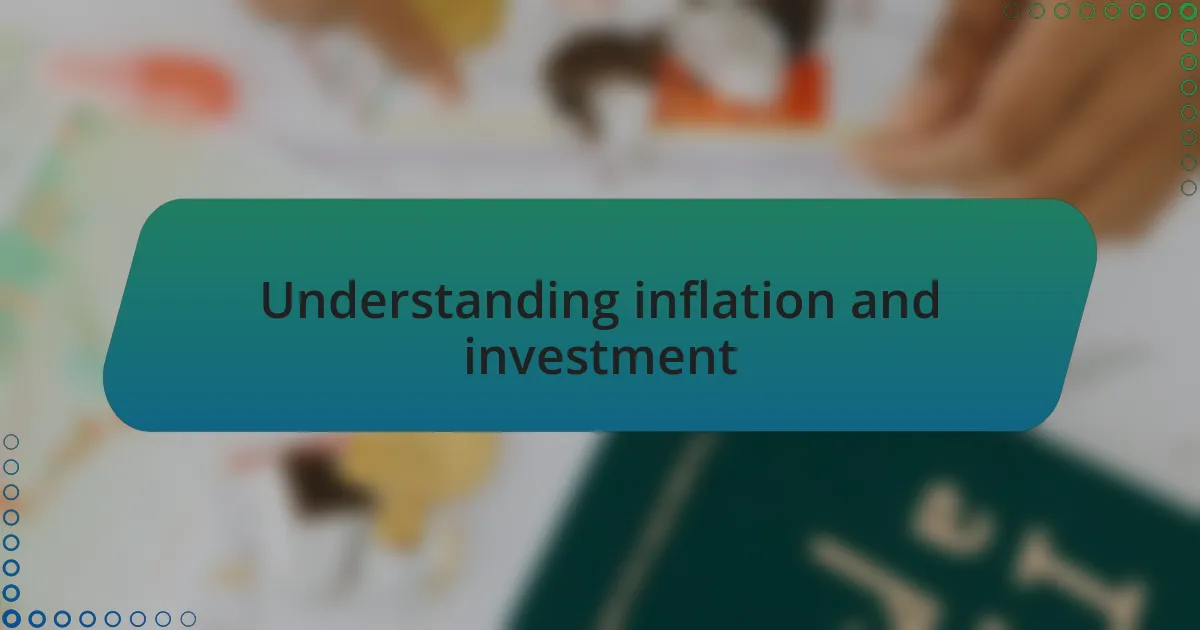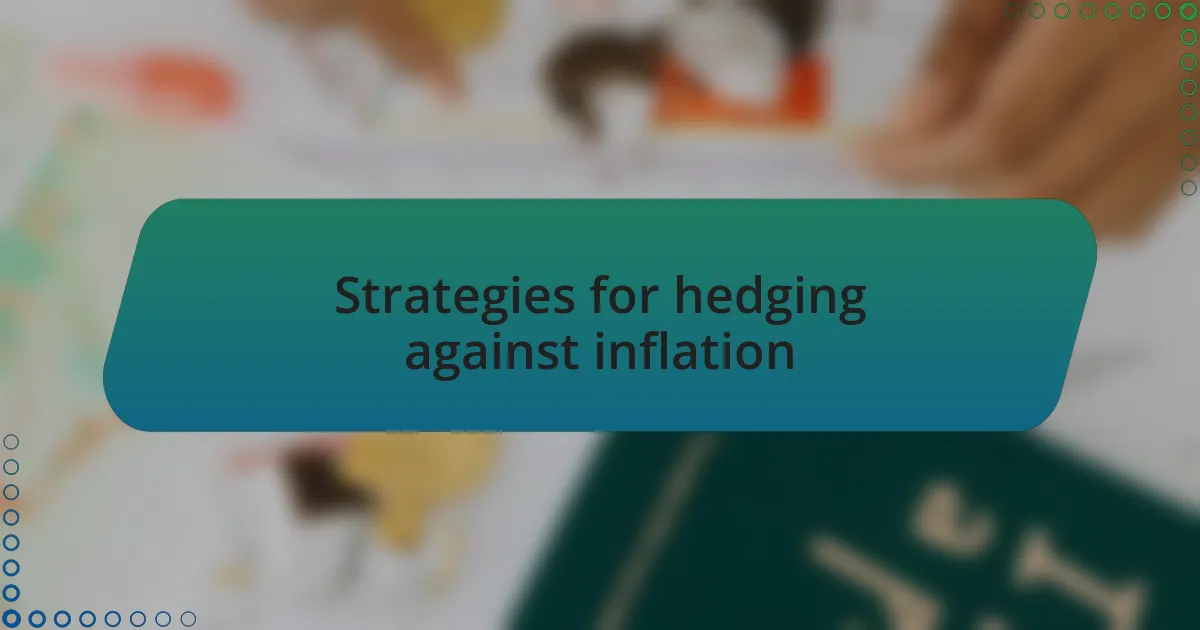Key takeaways:
- Inflation erodes purchasing power; investing requires a proactive approach to hedge against it.
- Diversifying investments into real assets and TIPS can effectively protect against inflation while providing stability.
- Prioritizing long-term thinking over short-term gains is essential for sustainable wealth growth.
- Market timing is often luck-driven; a focus on strategic, diversified investment can lead to better decision-making and performance.

Understanding inflation and investment
Inflation is often seen as a thief of purchasing power, and I’ve certainly felt the bite of rising prices on my daily expenses. When I recall my first investment in the stock market, I did so with the hope of outpacing inflation; it’s a common motive, but not always an easy task. How can we truly measure the effect of inflation on our investments over time?
Understanding the connection between inflation and investment is essential for anyone looking to grow their wealth. I remember attending a seminar where the speaker pointed out that without factoring in inflation, we might be overly optimistic about our returns. It was a pivotal moment for me; I realized that a nominal gain can be deceptive.
Investing requires a proactive approach to inflation. Personally, I’ve started focusing on assets that historically hedge against inflation, like real estate and commodities. Have you ever considered how inflation impacts your investment choices? I discovered that a well-rounded portfolio can make a significant difference in maintaining the real value of my investments in times of rising prices.

Strategies for hedging against inflation
One effective strategy I’ve implemented is diversifying my investments into real assets, like real estate. I recall purchasing my first rental property; it not only provided monthly cash flow but also appreciated in value, effectively outpacing inflation. Looking back, I truly appreciate how tangible assets can serve as a buffer, grounding my portfolio during uncertainty.
Another approach I’ve found valuable is investing in inflation-protected securities, such as Treasury Inflation-Protected Securities (TIPS). When I first learned about TIPS, I was intrigued by how they adjust with inflation. It felt like having a safety net; knowing that my principal rises with inflation gave me peace of mind during volatile market periods.
I also keep an eye on commodities, particularly precious metals like gold. I remember a time when fear gripped the markets, yet gold surged. It made me realize that in times of economic distress, investors flock to traditional safe havens, reinforcing my belief that commodities are an essential component of a well-rounded, inflation-hedged investment strategy. How prepared is your portfolio for inflation’s unpredictability?

My personal views on inflation
When I think about inflation, I often reflect on how it subtly erodes purchasing power over time. I remember a time when I calculated what I could buy with a dollar ten years ago compared to today. It was eye-opening; that realization fueled my determination to stay ahead of rising prices, ensuring my investments outpaced inflation rather than just keeping up.
I’ve observed that inflation seems like a silent thief, stealing value without us fully realizing it until it’s too late. A few years back, I watched a friend struggle as his fixed-income investments were decimated by rising prices. That experience left a mark on me; it highlighted the importance of being proactive about incorporating inflation-resilient assets into my portfolio.
One question I often ponder is whether inflation is just a temporary hurdle or a longer-term trend. During my market research, I’ve noticed that periods of high inflation have historically prompted shifts in investor sentiment. This understanding has led me to continuously adapt my strategies, keeping an eye on economic indicators to make informed decisions that safeguard my financial future against inflation’s unpredictable nature.

My investment philosophy
When it comes to my investment philosophy, I prioritize a balanced and diversified approach. I’ve learned that relying too heavily on one asset class can be risky. For instance, during the market downturn a couple of years ago, I felt the sting of being overly exposed to tech stocks. That experience taught me the value of spreading investments across different sectors and asset types, including real estate and commodities, to mitigate risks.
I firmly believe in the power of long-term thinking. I remember when I first started investing; I was eager to chase short-term gains. However, I quickly realized that lasting wealth is built over time, through consistent contributions and patience. It’s like tending to a garden—nurturing those investments daily can lead to a bountiful harvest years down the line.
Every investor faces moments of doubt, and I’ve certainly had my share. I often ask myself: what do I truly want from my investments? My answer is simple yet profound—I seek stability and growth. This clarity has driven me to focus not on quick wins but on sustainable growth strategies that align with my financial goals and values.

Lessons learned from past investments
Reflecting on my earlier investments, I learned that market timing is often more about luck than skill. I recall the time I sold my shares in a promising startup, convinced I was making a smart move before the inevitable dip. Little did I know, that company went on to skyrocket just months later. It was a painful lesson: sometimes, patience and a long-term perspective are far more valuable than the urge to act quickly.
Another key insight comes from my experience with inflation. During a particularly volatile period, I held onto cash longer than I should have, thinking of it as a safety net. However, inflation eroded the purchasing power of that cash, making it clear that sitting on the sidelines can be as risky as any investment. I’ve since shifted my focus towards assets that typically outpace inflation, like real estate and certain commodities, which have provided stability in uncertain times.
In terms of diversification, I used to feel overwhelmed by the sheer number of investment options available. Remembering when I dabbled in too many areas at once, I ended up diluting my efforts and confusing myself on where to allocate my resources. Over time, I learned that a focused yet diversified strategy allows for deeper insights into each investment, ultimately empowering better decision-making and enhancing overall portfolio performance. Wouldn’t you agree that understanding your investments is crucial for long-term success?